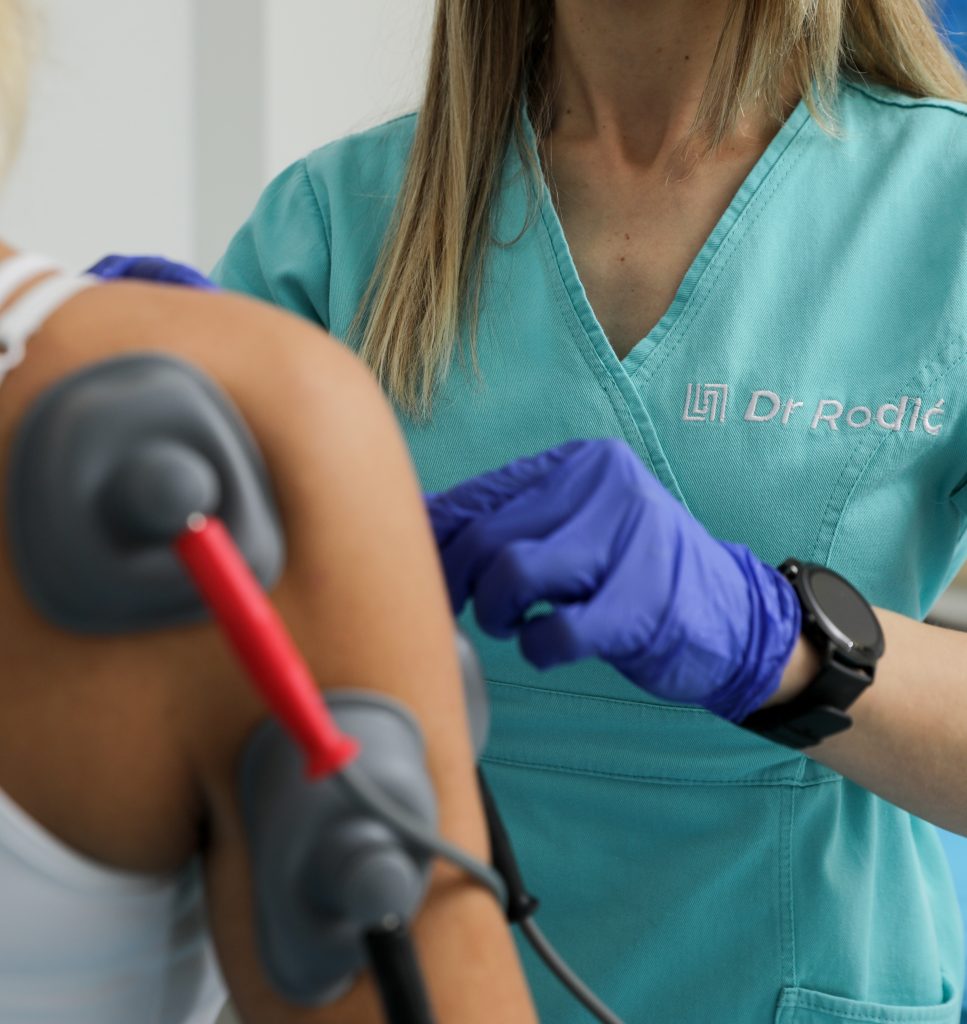Electrotherapy
Electrotherapy is a non-invasive treatment that uses electrical currents to stimulate nerves, muscles, and tissues. With the help of specialized devices that deliver targeted levels of stimulation, electrotherapy is used to treat injuries, reduce pain, and support the healing process.
Electrotherapy works by stimulating nerves and muscles through the surface of the skin. While the exact effects may vary depending on the type of device, there are several key mechanisms through which it produces therapeutic benefits.
It promotes the release of endorphins, the body’s natural pain relievers, and delivers electrical impulses that block or disrupt pain signals. Electrotherapy also triggers muscle contractions to help prevent atrophy and creates a mild thermal effect that improves circulation and supports healing. In addition, it stimulates cells with anti-inflammatory properties, enhances collagen production, and reduces pain sensitivity
Although there are different types of electrotherapy treatments, most follow a similar procedure. Electrodes are placed on the patient’s skin and connected by wires to a device operated by a physiotherapist, which delivers controlled electrical signals to the body.

There Are Several Types of Electrotherapy
Transcutaneous electrical nerve stimulation (TENS) uses low levels of electrical current to stimulate nerves and reduce pain.
Electrical Muscle Stimulation (EMS) delivers controlled impulses to the muscles, triggering contractions that strengthen muscle tissue and enhance circulation.
Interference current (IFC): Applies multiple electrical currents that overlap to create a therapeutic low-frequency current deep within the body, helping to reduce pain and relax muscles.
Galvanic stimulation: Uses continuous direct current to reduce inflammation and support tissue healing.
High Voltage Electrical Stimulation (HVES) delivers short bursts of high-voltage current that stimulate muscle contractions and promote blood flow.
What Are the Effects of Electrotherapy?
The electrical current used in physiotherapy influences the electrophysiological processes within cells. The most beneficial therapeutic effects include nerve and muscle stimulation, accelerated tissue regeneration, muscle relaxation, pain relief, reduction of inflammation, and overall support for the healing process.
That’s why electrotherapy is used both for sports injuries and in the treatment of neuromuscular disorders. It is also an essential component of rehabilitation for patients with physical impairments.
How Does Electrotherapy Work for Patients?
The wide range of electrotherapy applications and its beneficial effects on the body allow for positive therapeutic outcomes in many conditions. By dilating blood vessels and improving circulation, electrotherapy enhances tissue nourishment and promotes the body’s natural ability to heal and regenerate.
Electrotherapy improves comfort for patients with chronic conditions and supports the rehabilitation of those with musculoskeletal disorders. It provides anti-inflammatory and pain-relieving effects by stimulating the release of endorphins, while also promoting tissue nourishment and regulating muscle tone.
When Is Electrotherapy Used?
Electrotherapy supports recovery and rehabilitation in the following conditions:
Musculoskeletal disorders – arthrosis, degenerative and rheumatic diseases, discopathy, back pain, osteoporosis, arthritis, and periarticular tissue conditions.
Neurological disorders – sciatica, brachialgia, chronic inflammation of nerve plexuses and roots, neuralgia, peripheral nerve inflammation, and nerve root irritation.
Tissue-related conditions – scars and contractures, wound and ulcer healing, resorption of fluid buildup, hematomas, and swelling.
Injuries and trauma – fractures, muscle injuries, and injury-related pain.
Muscle weakness and impaired function – reduced muscle tone, electrostimulation of denervated muscles, support for muscle atrophy, rehabilitation of spastic paralysis, treatment of increased muscle tone, and enhancement of muscle strength and mass.
What are the contraindications to electrotherapy?
Electrotherapy should not be used in certain conditions, including pregnancy, malignancy, acute inflammation, bleeding or bleeding disorders, cardiac decompensation, the presence of pacemakers or metal implants, skin lesions, and open wounds or infections at the site of electrode placement.
Personalized Treatment Plans for Faster Recovery
Each patient receives a personalized treatment plan focused on restoring function and reducing pain. The approach targets the root cause of the problem—whether it’s an injury, a chronic condition, or post-surgical rehabilitation. Based on your diagnosis, condition, and goals, we create a tailored plan that may include manual therapy, therapeutic exercises, physical modalities, and specialized treatments.
Our goal is to help you reach maximum results in the shortest possible time, using the most effective and comfortable approach. We’re proud to say that, thanks to our extensive experience, full dedication, and state-of-the-art technology at Dr. Rodić’s clinic, we are able to avoid surgery in up to 80% of cases—while achieving the same or even better outcomes. At the same time, we reduce the need for medication and help you restore your quality of life quickly and without invasive procedures. In fact, our patients tend to recover up to 30% faster.
In therapy, we use a variety of treatments—therapeutic modalities that are an essential part of comprehensive physiatric care.
Our Patients’ Experiences Are Our Best Recommendation
Relief Begins With the Right Diagnosis
Early and accurate detection of the underlying cause is the first step toward effective treatment and a faster recovery.
